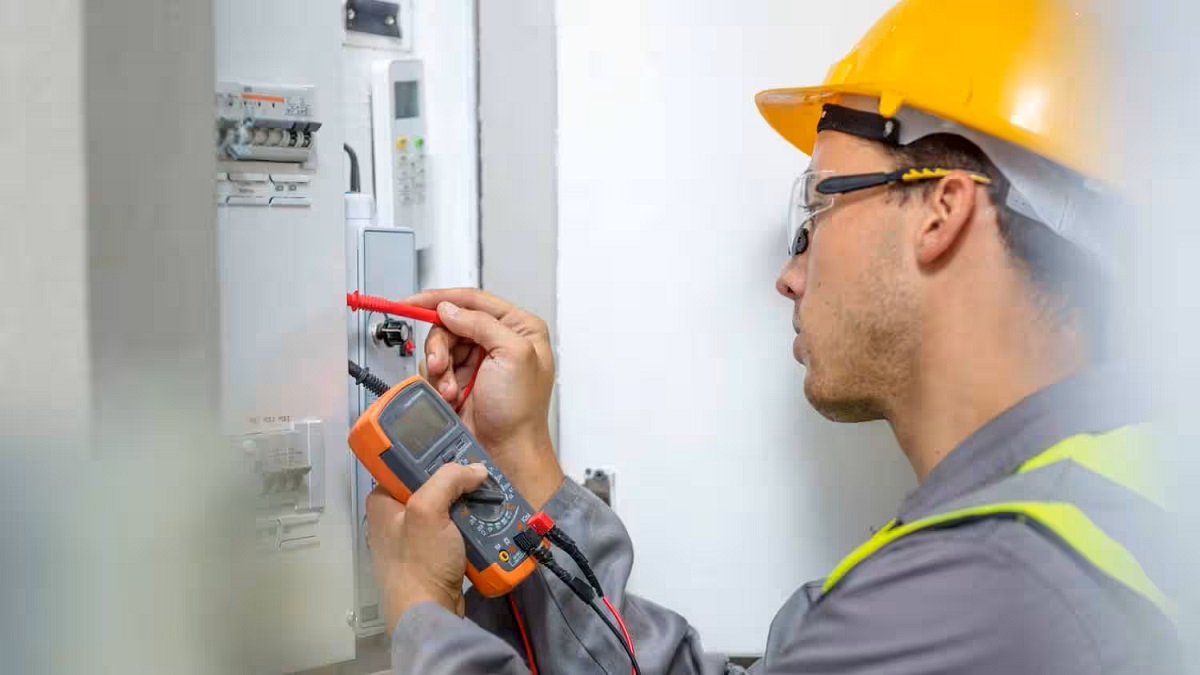Home>Home Maintenance>How To Write A Home Repair Request


Home Maintenance
How To Write A Home Repair Request
Modified: March 6, 2024
Learn how to write a home repair request with our comprehensive guide. Find expert tips for effective home maintenance.
(Many of the links in this article redirect to a specific reviewed product. Your purchase of these products through affiliate links helps to generate commission for Storables.com, at no extra cost. Learn more)
Introduction
Welcome to the world of home repair! Owning a home comes with its fair share of maintenance responsibilities. From leaky faucets to squeaky floors, there’s always something that needs fixing. Whether you’re a seasoned DIY enthusiast or prefer to hire professionals, it’s important to know how to write a compelling home repair request.
Writing a home repair request may seem like a simple task, but doing it effectively can make a significant difference in the outcome. A well-written request can help ensure that the issue is addressed promptly and resolved efficiently.
In this article, we will walk you through the step-by-step process of writing a home repair request. From assessing the issue to submitting the request, we will cover everything you need to know to maximize your chances of getting the repair done right.
So, whether you’re dealing with a leaky roof, a malfunctioning electrical outlet, or a clogged drain, let’s dive in and learn how to write a compelling home repair request that will catch the attention of those who can help.
Key Takeaways:
- Assess the urgency and severity of home repairs by documenting the issue with clear photos and evaluating the potential risks to safety and the home’s structure.
- Write a clear and concise home repair request, including specific details and any special instructions, to effectively communicate the issue and increase the chances of a prompt resolution.
Read more: How To Write A Blog On Home Improvement
Step 1: Assess the Home Repair Issue
Before you can write a home repair request, it’s essential to assess the issue at hand. This step involves identifying and evaluating the problem to determine its severity and urgency.
Identifying and evaluating the problem:
Take a close look at the area that requires repair. Identify the specific issue, such as a broken window, a leaking pipe, or a damaged wall. Consider the extent of the damage, whether it’s a minor cosmetic issue or a more significant structural problem. Understanding the nature and severity of the issue will help you communicate it effectively in your repair request.
Assessing the urgency of the repair:
Once you’ve identified the problem, it’s important to evaluate its urgency. Some repairs may be more time-sensitive than others, especially if they pose a risk to your safety or the structural integrity of your home. For example, a leaking roof or a malfunctioning electrical circuit requires immediate attention, while a minor cosmetic issue can be addressed at a later time. Determine the urgency of the repair to prioritize your request and expedite the resolution.
During the assessment process, it’s helpful to document the problem by taking photographs or videos. These visual aids will provide further evidence of the issue and help the repair personnel better understand the repairs needed. Make sure to capture clear images that clearly showcase the problem.
By thoroughly assessing the home repair issue, you will have a solid understanding of the problem and its urgency. This knowledge will guide you in the next step of gathering necessary information to include in your repair request.
Step 2: Gather Necessary Information
Once you have assessed the home repair issue and have a clear understanding of the problem, it’s time to gather the necessary information to include in your repair request. This step involves collecting details about the repair needed and documenting any relevant photos or videos.
Collecting details about the repair needed:
Take the time to gather all the relevant information about the repair. This includes specific details about the issue, such as the exact location of the problem in your home and any specific components or materials involved. Be as specific and detailed as possible, as this will help the repair personnel better understand the repair needed.
If applicable, provide any measurements or dimensions that are relevant to the repair. This can be particularly helpful for tasks like replacing a window or repairing a damaged wall. The more precise the information you provide, the smoother the repair process is likely to be.
Documenting any relevant photos or videos:
In addition to gathering written details about the repair, it’s also important to document the issue visually. Take photographs or videos that clearly capture the problem and any damage it has caused. This visual documentation will serve as evidence and support your written request.
When taking photos or videos, ensure that they are well-lit and clearly show the problem. Include different angles if necessary to provide a comprehensive view. You can also use annotations or labels to highlight specific areas of concern.
By gathering detailed information about the repair and documenting it visually, you will provide a comprehensive picture of the problem to the repair personnel. This will facilitate a better understanding of the issue and increase the chances of an accurate and efficient repair.
Step 3: Contact the Appropriate Parties
Once you have assessed the home repair issue and gathered the necessary information, it’s time to reach out to the appropriate parties to submit your repair request. This step involves determining who to contact and obtaining their contact information.
Determining who to contact for the repair request:
The first task is to identify the right person or organization to handle your repair request. Depending on the nature of the repair, this can vary. If you live in a rental property, you may need to contact your landlord or property management company. For homeowners, it may be necessary to contact a specific contractor, a handyman, or a warranty service provider, depending on the terms of your home warranty.
If you’re unsure who to contact, refer to any documentation related to your property, such as rental agreements, warranty documents, or homeowner association (HOA) guidelines. These resources should provide guidance on the appropriate contact for repairs.
Obtaining the contact information:
Once you have determined who to contact, the next step is to gather their contact information. This typically includes their name, phone number, email address, and any other relevant details such as business hours or preferred methods of communication.
If the contact information is not readily available, you may need to do some research. Utilize online directories, search engines, or contact your property management company to obtain the necessary information. It’s important to have the correct contact details to ensure that your repair request reaches the right person in a timely manner.
Keep the contact information in a readily accessible place so that you can easily reference it when submitting your repair request.
By contacting the appropriate parties and obtaining their contact information, you will be well-prepared to take the next step in writing and submitting your home repair request.
Be specific and detailed in your home repair request, including the exact issue, location, and any relevant information. This will help the repair person understand the problem and address it effectively.
Step 4: Compose the Home Repair Request
Now that you have assessed the home repair issue, gathered the necessary information, and identified the appropriate parties to contact, it’s time to compose your home repair request. This step involves writing a clear and concise description of the issue and including all essential details and specific instructions.
Writing a clear and concise description of the issue:
Start by providing a brief introduction to your repair request. State the problem clearly and concisely, using descriptive language to convey the severity and impact of the issue. For example, instead of saying “There’s a leak in the bathroom,” you could say “There’s a significant water leak in the bathroom, causing damage to the floor and walls.”
Next, provide specific details about the repair needed. Include information such as the exact location of the problem in your home, any components or materials involved, and the extent of the damage. Be as detailed as possible to help the repair personnel understand the issue fully. You can reference the photos or videos you took during the assessment process to support your description.
Including all essential details and specific instructions:
In addition to describing the issue, it’s important to include any other essential details in your repair request. This may include any specific requirements or preferences you have for the repair. For example, if you need a specific brand of replacement parts or if you have any special instructions for accessing the repair area, make sure to include those details.
If you have a deadline or urgency for the repair, be sure to communicate that as well. This will help the repair personnel prioritize your request accordingly.
Keep your request concise and to the point, avoiding unnecessary details or unrelated information. Using bulleted lists or numbered points can help organize the information and make it easier for the recipient to read and understand.
By composing a clear and concise home repair request, you ensure that the repair personnel have all the necessary information to address the issue effectively.
Read more: How To Write Off Home Renovations
Step 5: Submitting the Request
After composing your home repair request, the final step is to submit it to the appropriate parties. This step involves choosing the appropriate method to submit the request and following up on the submission if necessary.
Choosing the appropriate method to submit the request:
Consider the preferred method of communication for the party you need to contact. Common methods include email, phone call, online forms, or submitting a request through a property management portal. Refer to any instructions or guidelines provided by your landlord, property management company, or service provider to determine the preferred method.
If there are multiple options available, choose the method that you believe will be most efficient and effective in delivering your request. Keep in mind any deadlines or urgency you identified during the assessment process, and consider whether certain methods offer faster response times.
Following up on the submission if necessary:
After submitting your home repair request, it’s a good idea to follow up on the submission if you don’t receive a response within the expected timeframe. Some repair requests may require immediate attention, while others may have longer waiting periods. If you haven’t heard back within a reasonable amount of time, reach out to the appropriate party again to inquire about the status of your request.
When following up, be polite and professional in your communication. Remind the recipient about the details of your original request and emphasize your desire for a resolution. Keeping a record of your communication, including timestamps and any notes, can be helpful in case you need to escalate the request or refer back to the conversation later on.
Remember that repairs may take time, especially if they require sourcing materials or scheduling contractors. Patience is important, but it’s also essential to advocate for the prompt resolution of urgent issues.
By submitting your home repair request through the appropriate method and following up if necessary, you increase the chances of a timely response and resolution of the issue.
Conclusion
Congratulations! You have now learned how to write a comprehensive and effective home repair request. By following these steps and incorporating the necessary information, you can greatly increase the chances of getting your repair issue addressed promptly and efficiently.
Remember to assess the home repair issue accurately, gathering all the relevant details and assessing its urgency. Determine the appropriate parties to contact and obtain their contact information. Compose a clear and concise request, providing a detailed description of the issue and including any specific instructions or preferences. Finally, submit your request through the appropriate method, and don’t hesitate to follow up if necessary.
Effective communication is key when it comes to getting your home repairs addressed. By providing all the necessary information and being clear and concise in your request, you make it easier for the repair personnel to understand the issue and take appropriate action. This can save time, energy, and frustration for both parties involved.
Remember, the Home is where the heart is, and it’s important to keep it in good condition. Taking care of home repairs promptly can help maintain your home’s value and ensure a comfortable living environment for you and your loved ones.
So the next time you encounter a home repair issue, follow these steps and write a compelling home repair request that will grab the attention of those who can help. Equip yourself with the knowledge and confidence to communicate your repair needs effectively, and watch as your home gets the attention it deserves.
Frequently Asked Questions about How To Write A Home Repair Request
Was this page helpful?
At Storables.com, we guarantee accurate and reliable information. Our content, validated by Expert Board Contributors, is crafted following stringent Editorial Policies. We're committed to providing you with well-researched, expert-backed insights for all your informational needs.














